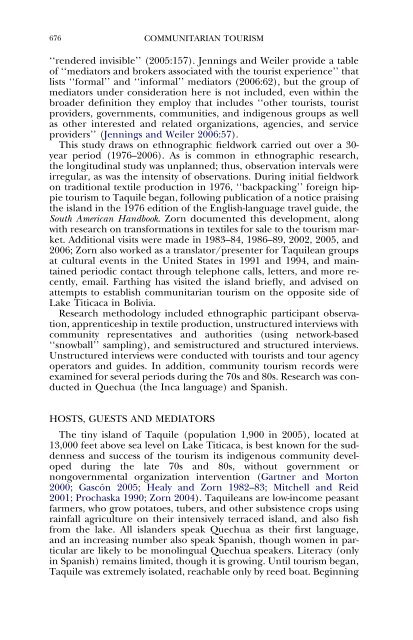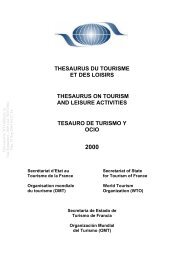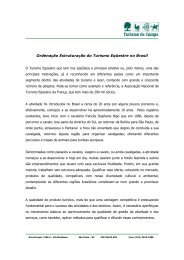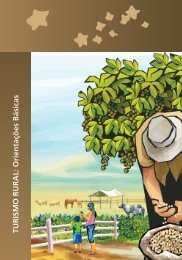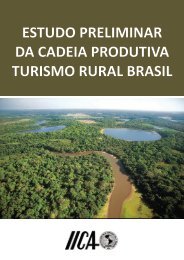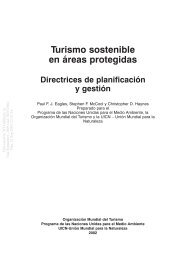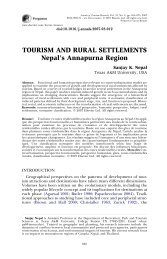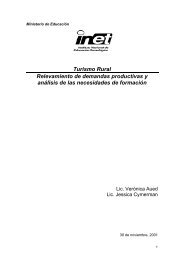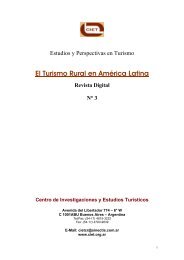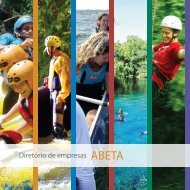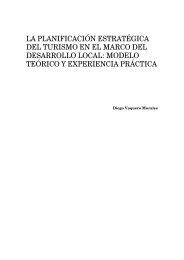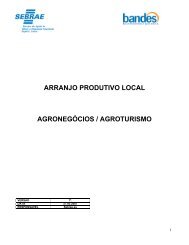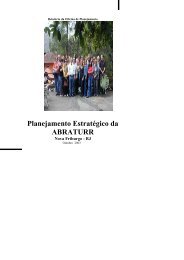COMMUNITARIAN TOURISM Hosts and Mediators in Peru
COMMUNITARIAN TOURISM Hosts and Mediators in Peru
COMMUNITARIAN TOURISM Hosts and Mediators in Peru
Create successful ePaper yourself
Turn your PDF publications into a flip-book with our unique Google optimized e-Paper software.
676 <strong>COMMUNITARIAN</strong> <strong>TOURISM</strong><br />
‘‘rendered <strong>in</strong>visible’’ (2005:157). Jenn<strong>in</strong>gs <strong>and</strong> Weiler provide a table<br />
of ‘‘mediators <strong>and</strong> brokers associated with the tourist experience’’ that<br />
lists ‘‘formal’’ <strong>and</strong> ‘‘<strong>in</strong>formal’’ mediators (2006:62), but the group of<br />
mediators under consideration here is not <strong>in</strong>cluded, even with<strong>in</strong> the<br />
broader def<strong>in</strong>ition they employ that <strong>in</strong>cludes ‘‘other tourists, tourist<br />
providers, governments, communities, <strong>and</strong> <strong>in</strong>digenous groups as well<br />
as other <strong>in</strong>terested <strong>and</strong> related organizations, agencies, <strong>and</strong> service<br />
providers’’ (Jenn<strong>in</strong>gs <strong>and</strong> Weiler 2006:57).<br />
This study draws on ethnographic fieldwork carried out over a 30-<br />
year period (1976–2006). As is common <strong>in</strong> ethnographic research,<br />
the longitud<strong>in</strong>al study was unplanned; thus, observation <strong>in</strong>tervals were<br />
irregular, as was the <strong>in</strong>tensity of observations. Dur<strong>in</strong>g <strong>in</strong>itial fieldwork<br />
on traditional textile production <strong>in</strong> 1976, ‘‘backpack<strong>in</strong>g’’ foreign hippie<br />
tourism to Taquile began, follow<strong>in</strong>g publication of a notice prais<strong>in</strong>g<br />
the isl<strong>and</strong> <strong>in</strong> the 1976 edition of the English-language travel guide, the<br />
South American H<strong>and</strong>book. Zorn documented this development, along<br />
with research on transformations <strong>in</strong> textiles for sale to the tourism market.<br />
Additional visits were made <strong>in</strong> 1983–84, 1986–89, 2002, 2005, <strong>and</strong><br />
2006; Zorn also worked as a translator/presenter for Taquilean groups<br />
at cultural events <strong>in</strong> the United States <strong>in</strong> 1991 <strong>and</strong> 1994, <strong>and</strong> ma<strong>in</strong>ta<strong>in</strong>ed<br />
periodic contact through telephone calls, letters, <strong>and</strong> more recently,<br />
email. Farth<strong>in</strong>g has visited the isl<strong>and</strong> briefly, <strong>and</strong> advised on<br />
attempts to establish communitarian tourism on the opposite side of<br />
Lake Titicaca <strong>in</strong> Bolivia.<br />
Research methodology <strong>in</strong>cluded ethnographic participant observation,<br />
apprenticeship <strong>in</strong> textile production, unstructured <strong>in</strong>terviews with<br />
community representatives <strong>and</strong> authorities (us<strong>in</strong>g network-based<br />
‘‘snowball’’ sampl<strong>in</strong>g), <strong>and</strong> semistructured <strong>and</strong> structured <strong>in</strong>terviews.<br />
Unstructured <strong>in</strong>terviews were conducted with tourists <strong>and</strong> tour agency<br />
operators <strong>and</strong> guides. In addition, community tourism records were<br />
exam<strong>in</strong>ed for several periods dur<strong>in</strong>g the 70s <strong>and</strong> 80s. Research was conducted<br />
<strong>in</strong> Quechua (the Inca language) <strong>and</strong> Spanish.<br />
HOSTS, GUESTS AND MEDIATORS<br />
The t<strong>in</strong>y isl<strong>and</strong> of Taquile (population 1,900 <strong>in</strong> 2005), located at<br />
13,000 feet above sea level on Lake Titicaca, is best known for the suddenness<br />
<strong>and</strong> success of the tourism its <strong>in</strong>digenous community developed<br />
dur<strong>in</strong>g the late 70s <strong>and</strong> 80s, without government or<br />
nongovernmental organization <strong>in</strong>tervention (Gartner <strong>and</strong> Morton<br />
2000; Gascón 2005; Healy <strong>and</strong> Zorn 1982–83; Mitchell <strong>and</strong> Reid<br />
2001; Prochaska 1990; Zorn 2004). Taquileans are low-<strong>in</strong>come peasant<br />
farmers, who grow potatoes, tubers, <strong>and</strong> other subsistence crops us<strong>in</strong>g<br />
ra<strong>in</strong>fall agriculture on their <strong>in</strong>tensively terraced isl<strong>and</strong>, <strong>and</strong> also fish<br />
from the lake. All isl<strong>and</strong>ers speak Quechua as their first language,<br />
<strong>and</strong> an <strong>in</strong>creas<strong>in</strong>g number also speak Spanish, though women <strong>in</strong> particular<br />
are likely to be monol<strong>in</strong>gual Quechua speakers. Literacy (only<br />
<strong>in</strong> Spanish) rema<strong>in</strong>s limited, though it is grow<strong>in</strong>g. Until tourism began,<br />
Taquile was extremely isolated, reachable only by reed boat. Beg<strong>in</strong>n<strong>in</strong>g


